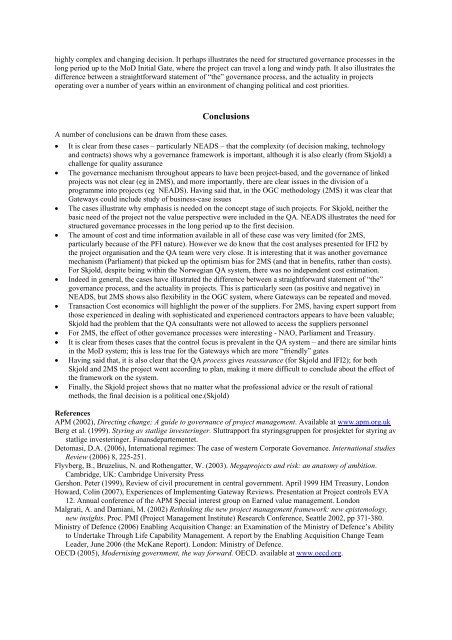Link to thesis. - Concept - NTNU
Link to thesis. - Concept - NTNU
Link to thesis. - Concept - NTNU
- No tags were found...
Create successful ePaper yourself
Turn your PDF publications into a flip-book with our unique Google optimized e-Paper software.
highly complex and changing decision. It perhaps illustrates the need for structured governance processes in thelong period up <strong>to</strong> the MoD Initial Gate, where the project can travel a long and windy path. It also illustrates thedifference between a straightforward statement of “the” governance process, and the actuality in projectsoperating over a number of years within an environment of changing political and cost priorities.ConclusionsA number of conclusions can be drawn from these cases.• It is clear from these cases – particularly NEADS – that the complexity (of decision making, technologyand contracts) shows why a governance framework is important, although it is also clearly (from Skjold) achallenge for quality assurance• The governance mechanism throughout appears <strong>to</strong> have been project-based, and the governance of linkedprojects was not clear (eg in 2MS), and more importantly, there are clear issues in the division of aprogramme in<strong>to</strong> projects (eg NEADS). Having said that, in the OGC methodology (2MS) it was clear thatGateways could include study of business-case issues• The cases illustrate why emphasis is needed on the concept stage of such projects. For Skjold, neither thebasic need of the project not the value perspective were included in the QA. NEADS illustrates the need forstructured governance processes in the long period up <strong>to</strong> the first decision.• The amount of cost and time information available in all of these case was very limited (for 2MS,particularly because of the PFI nature). However we do know that the cost analyses presented for IFI2 bythe project organisation and the QA team were very close. It is interesting that it was another governancemechanism (Parliament) that picked up the optimism bias for 2MS (and that in benefits, rather than costs).For Skjold, despite being within the Norwegian QA system, there was no independent cost estimation.• Indeed in general, the cases have illustrated the difference between a straightforward statement of “the”governance process, and the actuality in projects. This is particularly seen (as positive and negative) inNEADS, but 2MS shows also flexibility in the OGC system, where Gateways can be repeated and moved.• Transaction Cost economics will highlight the power of the suppliers. For 2MS, having expert support fromthose experienced in dealing with sophisticated and experienced contrac<strong>to</strong>rs appears <strong>to</strong> have been valuable;Skjold had the problem that the QA consultants were not allowed <strong>to</strong> access the suppliers personnel• For 2MS, the effect of other governance processes were interesting - NAO, Parliament and Treasury.• It is clear from theses cases that the control focus is prevalent in the QA system – and there are similar hintsin the MoD system; this is less true for the Gateways which are more “friendly” gates• Having said that, it is also clear that the QA process gives reassurance (for Skjold and IFI2); for bothSkjold and 2MS the project went according <strong>to</strong> plan, making it more difficult <strong>to</strong> conclude about the effect ofthe framework on the system.• Finally, the Skjold project shows that no matter what the professional advice or the result of rationalmethods, the final decision is a political one.(Skjold)ReferencesAPM (2002), Directing change; A guide <strong>to</strong> governance of project management. Available at www.apm.org.ukBerg et al. (1999). Styring av statlige investeringer. Sluttrapport fra styringsgruppen for prosjektet for styring avstatlige investeringer. Finansdepartementet.De<strong>to</strong>masi, D.A. (2006), International regimes: The case of western Corporate Governance. International studiesReview (2006) 8, 225-251.Flyvberg, B., Bruzelius, N. and Rothengatter, W. (2003). Megaprojects and risk: an ana<strong>to</strong>my of ambition.Cambridge, UK: Cambridge University PressGershon. Peter (1999), Review of civil procurement in central government. April 1999 HM Treasury, LondonHoward, Colin (2007), Experiences of Implementing Gateway Reviews. Presentation at Project controls EVA12. Annual conference of the APM Special interest group on Earned value management. LondonMalgrati, A. and Damiani, M. (2002) Rethinking the new project management framework: new epistemology,new insights. Proc. PMI (Project Management Institute) Research Conference, Seattle 2002, pp 371-380.Ministry of Defence (2006) Enabling Acquisition Change: an Examination of the Ministry of Defence’s Ability<strong>to</strong> Undertake Through Life Capability Management. A report by the Enabling Acquisition Change TeamLeader, June 2006 (the McKane Report). London: Ministry of Defence.OECD (2005), Modernising government, the way forward. OECD. available at www.oecd.org.
















